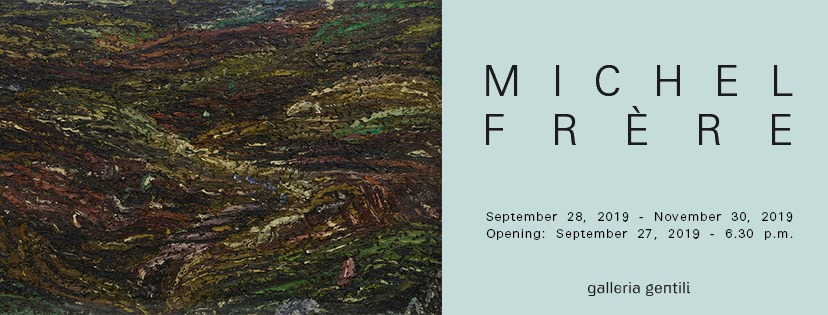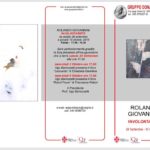Michel Frère – Galleria Gentili – Firenze
Michel Frère
at Galleria Gentili
Firenze
27 settembre – 30 novembre 2019
Inaugurazione venerdì 27 settembre ore 18.30
______________________________________
English and French version below
______________________________________
Galleria Gentili ha il piacere di inaugurare la nuova stagione espositiva con una mostra personale di Michel Frère (1961, Bruxelles -1999, Morlanwelz).
“This is one of the reasons the paintings are so thick. They are an unending accumulation of errors and disillusionments. But, I guess, always done with a certain kind of Utopian spirit.”
Michel Frère
La ricerca di Michel Frère sembra essersi interrotta troppo presto, e in un momento in cui riceveva ancora poco spazio e poca attenzione per il tipo di pittura praticata.
Per tutti coloro che hanno avuto la fortuna di conoscerla, è quindi impossibile non restare ossessionati dalla certezza che questa meritasse uno spazio molto più importante di quello che ha poi effettivamente occupato.
Michel Frère ha dipinto per quindici anni circa, a partire dalla metà degli anni 80.
Prende parte ad un momento storico in cui, ai due lati della costa atlantica, si assiste a un ritorno della pittura.
Se in un primo momento, Michel Frère si è confrontato con opere figurative emblematiche di quel decennio – tra la transavanguardia e il neo-espressionismo, è nella materia pittorica stessa che trova una strada che non abbandonerà più.
Grande estimatore di Poussin e di Constable, Frère elabora delle opere in cui l’astrazione si trasforma in paesaggio.
Tratta la pittura ad olio attraverso un’applicazione sequenziale di spessi strati di materia, animati da un movimento pulito che genera una sovrapposizione delle direzioni del gesto.
Michel Frère ha poi l’abitudine di inquadrare sotto vetro le sue grandi composizioni come per porre una distanza all’intensità del gesto pittorico.
Ogni sua opera necessita di un impegno ‘’furioso’’, duraturo e fisico. Il colore si imprime di tonalità dominanti che si risvegliano nella moltitudine di dettagli.
Ogni opera è un mondo, allo stesso tempo fisico e temporale : l’incarnazione di un coinvolgimento totale.
Paragoniamo spesso le sue opere a quelle di Eugène Leroy, che Frère ha molto ammirato e con il quale ha condiviso questo singolare interesse per la pittura di ‘’spessore’’.
Leroy però non ha mai abbandonato il soggetto e le sue opere non hanno la qualità lirica di quelle di Michel Frère.
Rivedere le opere di Michel Frère in Toscana acquista tutto il suo senso quando si viene a conoscenza del lungo periodo che passò a Montecatini, luogo in cui amava dipingere.
Le tonalità che caratterizzano questo periodo testimoniano il modo in cui l’astrazione di Michel Frère è collegata al paesaggio fisico e mentale in cui era immerso.
È in questa serie eccezionale che la sua capacità di catturare la materialità del mondo e le sue vibrazioni è maggiormente visibile e lo spirito d’utopia – che non l’ha mai abbandonato – risuona qui con maggior potenza.
Testo di Anne Pontégnie
***
Michel Frère, pittore belga, nato a Bruxelles nel 1961 e morto a Morlanwelz nel 1999.
Le sue opere sono state esposte con Galleria Gentili, Firenze nel 1993, 1995, 1997 e nel 2005. Tra le mostre selezionate: una personale al Kunst Rai 86 di Amsterdam, Olanda nel 1986 e al C.I.A.P di Hasselt, Belgio nel 1987. Gli sono inoltre state dedicate retrospettive in istituzioni in Belgio come il Palais Des Beaux-Arts di Charleroi nel 1996, il MAC’s Grand-Hornu,Hornu nel 2002 e il Musée Dhondt-Dhaenens di Deurle, nel 2011.
_______________________________________________
Galleria Gentili is pleased to inaugurate the new exhibition season with a solo show by Michel Frère (1961, Brussels -1999, Morlanwelz).
“This is one of the reasons the paintings are so thick. They are an unending accumulation of errors and disillusionments. But, I guess, always done with a certain kind of Utopian spirit.”
Michel Frère
Michel Frère’s research seems to have been cut short all too soon, and at a time when his work was still given little space and received little attention owing to the kind of painting he practiced.
So for all those who had the fortune to know him, it is impossible not to be racked by the certainty that it deserved to have much more space than it was actually given.
Michel Frère painted for around fifteen years, commencing in the mid-1980s.
This was at a moment in history which, on both sides of the Atlantic, saw a return to painting.
While at the outset Michel Frère produced figurative works emblematic of that decade – somewhere between the Transavanguardia and Neo-Expressionism, it was in the paint itself that he found a road he was never to abandon.
A great admirer of Poussin and Constable, Frère painted pictures in which abstraction was transformed into landscape.
His method of painting in oil entailed a sequential application of thick layers of pigment, animated by a clean movement that resulted in a superimposition of the directions of the brushwork.
Michel Frère also had the habit of framing his large compositions under glass as if he wished to place the viewer at a distance from the intensity of those strokes of the brush.
Each of his works required a ‘violent’, lasting and physical effort. The colour is imbued with dominant tones that are roused in the multitude of details.
Each work is a world, at once a physical and temporal one: the embodiment of a total involvement.
We often compare his works with those of Eugène Leroy, whom Frère greatly admired and with whom he shared this singular interest in painting of ‘thickness’.
But Leroy never abandoned the subject and his works do not have the lyrical quality of Michel Frère’s.
To see the works of Michel Frère in Tuscany again takes on its full significance when one takes account of the long period he spent in Montecatini, a place where he loved to paint.
The tonalities that characterized this period bear witness to the way in which Michel Frère’s abstraction is connected to the physical and mental landscape in which he was immersed.
It is in this exceptional series that his ability to capture the material quality of the world and its vibrations is most visible and it is here too that the spirit of utopia – which never left him – resounds with most power.
Text by Anne Pontégnie
***
Michel Frère, is a Belgian painter, born in Brussels in 1961 and died in Morlanwelz in 1999.
His works have been exhibited with Galleria Gentili, Florence in 1993, 1995, 1997 and 2005. Among the selected exhibitions: a solo exhibition at the Kunst Rai 86 in Amsterdam, Holland in 1986 and at the C.I.A.P. in Hasselt, Belgium in 1987. Retrospective shows has been dedicated to him by several institutions in Belgium, such as the Palais Des Beaux-Arts in Charleroi in 1996, the MAC’s Grand-Hornu, Hornu in 2002 and the Musée Dhondt-Dhaenens of Deurle, in 2011.
______________________________________________________
Galleria Gentili a le plaisir d’inaugurer la nouvelle saison d’exposition avec une exposition personnelle de Michel Frère (1961, Bruxelles -1999, Morlanwelz).
“This is one of the reasons the paintings are so thick. They are an unending accumulation of errors and disillusionments. But, I guess, always done with a certain kind of Utopian spirit.”
Michel Frère
L’œuvre de Michel Frère a été interrompue trop tôt, et à un moment où il y avait peu de place et peu de regards pour la peinture qu’il pratiquait. Pour tous ceux qui ont la chance de connaître sa peinture, il est pourtant impossible de ne pas être hanté par la certitude qu’elle mérite une place beaucoup plus importante que celle qu’elle occupe.
Michel Frère a peint pendant une quinzaine d’années, depuis le milieu des années 80. Il participe d’un moment où des deux côtés de l’atlantique la peinture fait son retour. Si dans un premier temps, Michel Frère s’essaye à des œuvres figuratives emblématiques de cette décennie – entre transavantgarde et neo-expressionnisme, il trouve rapidement dans la matière picturale même une piste qu’il n’abandonnera plus. Grand amateur de Poussin et de Constable, Frère élabore des œuvres dont l’abstraction est aussi paysage. La peinture à l’huile est travaillée en couches épaisses successives chacune animée d’un mouvement propre dont les directions se chevauchent. Michel Frère prend alors l’habitude d’encadrer ses larges compositions derrière une vitre comme pour mettre à distance l’intensité du geste pictural. Chaque œuvre nécessite un travail acharné, long et physique. La couleur est apportée par des tonalités dominantes réveillées d’une multitude de détails. Chaque œuvre est un monde, à la fois physique et temporel : l’incarnation d’un engagement total. On compare souvent son œuvre avec celle d’Eugène Leroy que Frère admirait beaucoup et avec qui il partage ce travail si singulier de la peinture en épaisseur. Mais Leroy n’a jamais abandonné le sujet et ses œuvres n’ont pas la qualité lyrique de celles de Michel Frère.
Revoir les œuvres de Michel Frère en Toscane prend tout son sens quand on sait qu’il a passé de longs mois à Montecatini où il aimait peindre. Les tonalités qui caractérisent cette période témoigne de la manière dont l’abstraction de Michel Frère est connectée au paysage physique et mental dans lequel il était immergé. C’est dans cette série exceptionnelle que sa capacité à capturer la matière du monde dans son frémissement est sans doute le plus visible, que l’esprit d’utopie qui ne l’a jamais abandonné résonne avec le plus de puissance.
Texte écrit par Anne Pontégnie
***
Michel Frère, peintre belge, né à Bruxelles en 1961 et mort à Morlanwelz en 1999.
Ses œuvres ont été exposées à Galleria Gentili, Florence en 1993, 1995, 1997 et 2005. Parmi les expositions sélectionnées: une exposition personnelle au Kunst Rai 86,Amsterdam, Pays-Bas en 1986, et au C.I.A.P, Hasselt, Belgique, en 1987. Des rétrospectives ont également été consacrées par des institutions en Belgique, telles que le Palais Des Beaux-Arts de Charleroi en 1996, le MAC Grand Hornu, Hornu en 2002 et le musée Dhondt-Dhaenens de Deurle en 2011.




